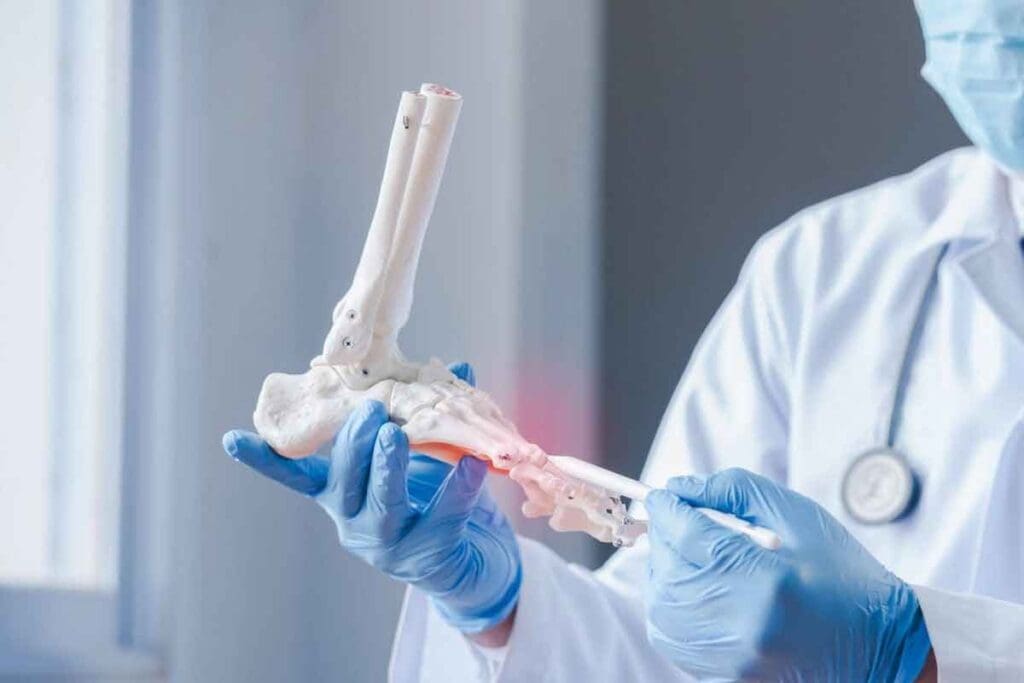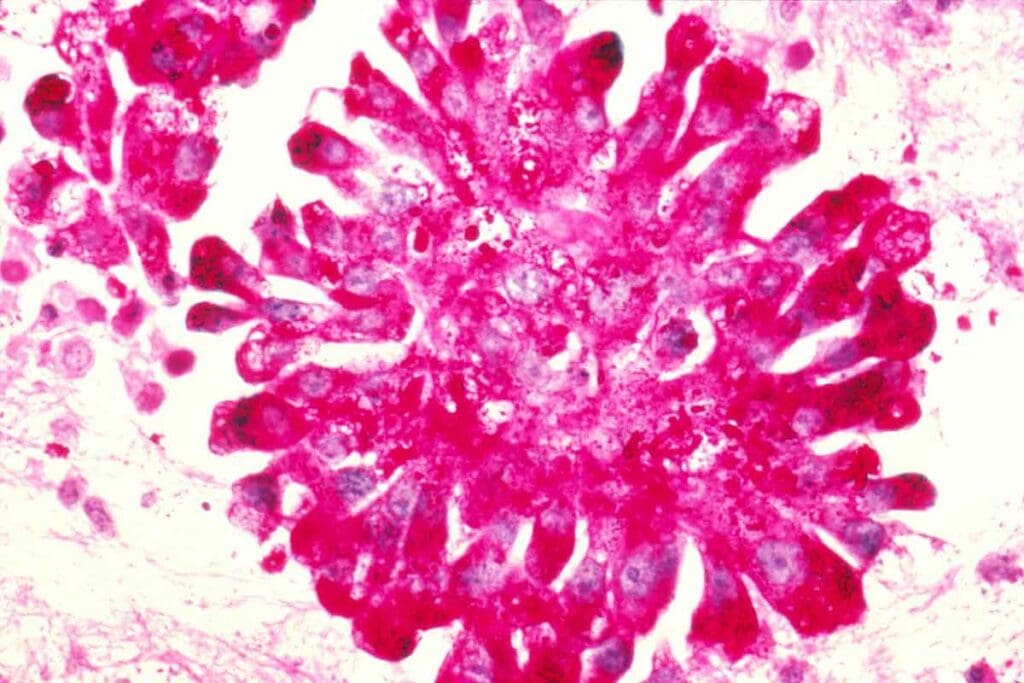Last Updated on November 20, 2025 by Ugurkan Demir

Ewing sarcoma is a rare and aggressive malignant bone and soft tissue tumor. It mainly affects children and teens. It often starts in the pelvis, femur, or long bones, but can happen in any bone or soft tissue.
About 25 to 30 percent of patients have metastatic Ewing sarcoma. This means the cancer has spread, often to the lungs and other bones. The staging of Ewing sarcoma is key to figuring out the prognosis and treatment plan.
For local disease, the 5-year survival rate is about 70 to 75 percent. But, for metastatic Ewing’s sarcoma, the survival rate drops below 30 percent.

Ewing sarcoma is a rare and aggressive cancer. It mainly affects the bones and soft tissues of kids and teens. It grows fast and can spread to other parts of the body.
Ewing sarcoma starts in bones or soft tissues and grows aggressively. It can happen in any bone or soft tissue. But it’s most common in the legs, pelvis, and chest.
Ewing sarcoma is a rare cancer, making up about 1% of all childhood cancers. It grows and spreads quickly if not treated fast. Knowing about Ewing sarcoma helps find it early and treat it well.
Ewing sarcoma mostly hits kids and young adults. Most cases are found in people under 20. It’s more common in boys than girls and rare in adults over 30.
The study of Ewing sarcoma shows it’s a big health issue for young people. We need to keep learning about it and find better ways to treat it.

Understanding Ewing sarcoma’s biology is key to finding effective treatments. This aggressive tumor mainly affects kids and teens. It’s a rare but serious bone and soft tissue cancer.
Ewing sarcoma has specific genetic changes that impact bone cell function. These changes are vital for grasping how the disease develops and grows.
The disease’s cellular and molecular features include complex genetic alterations. Chromosomal translocations create oncogenic fusion proteins. These proteins cause cells to grow and divide without control, leading to tumors.
Key Molecular Features:
Chromosomal translocation is essential in Ewing sarcoma’s development. The t(11;22)(q24;q12) translocation fuses the EWS and FLI1 genes. This creates the EWS-FLI1 fusion protein.
“The EWS-FLI1 fusion protein acts as a transcription factor, altering the expression of target genes involved in cell proliferation, apoptosis, and differentiation, driving tumorigenesis.”
This genetic change is a key sign of Ewing sarcoma, found in about 85% of cases. Knowing how EWS-FLI1 contributes to tumor growth is vital for creating targeted treatments.
| Chromosomal Translocation | Frequency | Resulting Fusion Protein |
| t(11;22)(q24;q12) | 85% | EWS-FLI1 |
| t(21;22)(q22;q12) | 5-10% | EWS-ERG |
Researchers are studying the causes of Ewing cancer. They have found links to genetic predispositions and mutations. These changes affect how bone cells grow and divide.
Genetics are key in Ewing sarcoma. The disease is linked to a specific genetic change. This change leads to the creation of a harmful protein.
Studies show that genetic mutations can increase the risk. This is important for understanding the disease.
Environmental and developmental factors also play a role. While the evidence is not as strong, some studies suggest a link. Knowing these factors helps identify those at higher risk.
The relationship between genetics and environment in Ewing sarcoma is complex. More research is needed to understand the disease better. This could lead to ways to prevent it.
Ewing sarcoma can be found in different bones and soft tissues. It often shows up in specific areas. Knowing where it usually happens helps doctors find it early.
Ewing sarcoma often starts in the lower legs, pelvis, and chest area. The most common bones affected are:
The pelvis and femur are the most common places for Ewing sarcoma. It usually happens in the middle part of long bones. The femur is very prone, leading to serious problems because of its importance in walking and moving.
| Bone | Frequency of Involvement |
| Pelvis | High |
| Femur | High |
| Tibia/Fibula | Moderate |
| Humerus | Moderate |
Ewing sarcoma can also appear in soft tissues, known as extraosseous Ewing sarcoma. This type makes up a big part of Ewing sarcoma cases. It can happen in any soft tissue, but it’s less common than bone Ewing sarcoma.
“Extraosseous Ewing sarcoma presents a diagnostic challenge due to its similarity in presentation to other soft tissue sarcomas, necessitating a thorough diagnostic workup.”
In summary, Ewing sarcoma often targets the pelvis and long bones, but also soft tissues. Knowing where it usually occurs is key for early diagnosis and treatment.
It’s important to know the signs of Ewing Sarcoma early. This rare tumor mainly hits kids and teens. It’s a serious bone and soft tissue cancer.
Signs near the tumor are key for doctors to spot. Look for pain, swelling, and trouble moving around the tumor area.
Pain is often the first sign, with swelling soon after. As the tumor grows, it can make it hard to move. For example, a tumor in a limb might make it hard to use that limb.
Ewing Sarcoma also has signs that show up all over the body. Look out for fever, weight loss, and feeling very tired. These signs mean the disease might be spreading.
Knowing the different symptoms of Ewing Sarcoma helps doctors catch it early. This can lead to better treatment and outcomes for patients.
Diagnosing Ewing sarcoma involves several steps. These include imaging tests and molecular diagnostic methods. Getting an accurate diagnosis is key to understanding the disease’s extent and planning treatment.
Imaging tests are essential for diagnosing and staging Ewing sarcoma. They help doctors see the tumor and its size, location, and spread.
Several imaging methods are used to diagnose Ewing sarcoma, including:
A biopsy is vital for confirming Ewing sarcoma diagnosis. It involves removing a tumor sample for microscopic examination.
The biopsy’s pathological assessment helps differentiate Ewing sarcoma from other tumors. It also provides insights into the tumor’s aggressiveness.
Molecular and genetic testing are critical in diagnosing Ewing sarcoma. These tests look for specific genetic abnormalities, like the EWS-FLI1 fusion gene.
Genetic testing confirms the diagnosis and offers prognostic information. This helps guide treatment decisions.
It’s important to know the staging and classification systems for Ewing sarcoma. This helps plan treatment effectively. Ewing sarcoma is classified as localized, metastatic, or recurrent. The stage shows how far the cancer has spread in the body.
The TNM system is a common way to stage cancer, including Ewing sarcoma. It looks at the tumor size (T), nearby lymph nodes (N), and if the cancer has spread (M). This helps doctors figure out how far the disease has spread and plan treatment.
Key components of the TNM classification include:
Ewing sarcoma can be either localized or metastatic. Localized means the cancer is only at the original site. Metastatic means it has spread to other parts of the body. This is key for knowing the prognosis and treatment.
The difference between localized and metastatic disease is very important. It affects treatment choices and how well a patient will do.
Getting the staging and classification right for Ewing sarcoma is critical. It ensures patients get the right care. Doctors can then tailor treatments to fit each patient’s needs.
It’s key to know about metastatic risks in Ewing sarcoma for good treatment plans. This cancer is very aggressive and often hits kids and young adults. It can spread, making treatment harder.
The cancer often spreads to the lungs and other bones. About 25% of patients have it spread when they’re first diagnosed.
The lungs are the top place for cancer to spread, followed by other bones. Spreading to these areas means a tougher fight ahead.
| Site of Metastasis | Frequency | Prognostic Impact |
| Lungs | High | Poor |
| Other Bones | Moderate | Poor |
| Bone Marrow | Less Common | Very Poor |
Finding cancer spread in Ewing sarcoma uses imaging and biopsies. Imaging techniques like CT scans, MRI, and PET scans help spot where the cancer has gone.
Many things affect how likely Ewing sarcoma is to spread. These include the tumor’s size, where it is, and its genetic makeup. Knowing these helps doctors plan better treatments.
By knowing where cancer spreads and what makes it spread, doctors can make treatments better for Ewing sarcoma.
Managing Ewing Sarcoma requires a team effort. Children with this disease need a treatment plan from experts in pediatric cancer care.
Multimodal therapy is key in treating Ewing Sarcoma. It includes chemotherapy, surgery, and radiation therapy. This combination aims to fight the cancer more effectively.
The table below shows the treatment options for Ewing Sarcoma:
| Treatment Modality | Description |
| Chemotherapy | Uses drugs to kill cancer cells |
| Surgery | Removes the tumor and surrounding tissue |
| Radiation Therapy | Employs high-energy rays to destroy cancer cells |
| Stem Cell Transplant | Replaces damaged stem cells with healthy ones |
For localized Ewing Sarcoma, treatment often combines chemotherapy with surgery and/or radiation. The goal is to remove the tumor and stop it from coming back.
When Ewing Sarcoma spreads or comes back, treatment gets more intense. It may include stronger chemotherapy, targeted therapy, and stem cell transplant. The treatment plan depends on how far the disease has spread and the patient’s health.
Knowing about the different treatments helps doctors create a good plan for Ewing Sarcoma patients.
The outlook for Ewing sarcoma depends on several important factors. These include the disease’s stage and how far it has spread. Knowing these details helps doctors choose the best treatment and predict how well a patient will do.
Several factors are key in figuring out how long a patient with Ewing sarcoma might live. These include:
Survival rates for Ewing sarcoma change based on the disease’s stage and spread. For Ewing sarcoma that hasn’t spread, the 5-year survival rate is about 70 to 75 percent. But for Ewing sarcoma that has spread, the survival rate drops below 30 percent.
| Disease Stage | 5-Year Survival Rate |
| Localized | 70-75% |
| Metastatic | <30% |
People with Ewing sarcoma are at risk for the disease coming back, often in the first few years after treatment. It’s important to keep an eye on them to catch any signs of the disease coming back early.
Key Factors Influencing Recurrence:
Regular check-ups and scans are key to watching for disease return and managing treatment side effects over time.
Ewing’s sarcoma is a rare and aggressive cancer that mainly affects kids and teens. It can grow in bones or soft tissues. Knowing about Ewing sarcoma is key to creating good treatment plans and better patient results.
The disease’s traits, like its spread and how it grows, are important for knowing how well a patient will do. Understanding the causes, how it’s staged, and what affects its growth helps doctors give better care.
New treatments have made it easier for people with Ewing’s sarcoma to live longer if it’s caught early. But, for those with it spreading or coming back, the outlook is harder. Keeping up with research and knowing about Ewing tumor and Ewings sarcoma is important for better care and life quality.
By learning more about Ewing sarcoma, doctors can handle this complex disease better. This leads to better treatments and outcomes for patients.
Ewing’s sarcoma is a rare and aggressive cancer. It mainly affects the bones and soft tissues of kids and teens.
It often shows up in the pelvis, femur, and other long bones. It can also appear in soft tissues.
Symptoms include swelling, pain, and fever. These signs depend on where the tumor is.
Genetics play a big role in Ewing’s sarcoma. Certain genetic changes affect bone cell function.
It’s staged using the TNM system. This shows if the cancer is local, has spread, or has come back.
Metastasis often happens in the lungs and other bones.
Treatment includes chemotherapy, surgery, and radiation. It’s a multi-step approach.
Factors like disease extent matter. Localized disease has a better outlook than spread disease.
Yes, it’s a malignant cancer.
Prognosis varies based on disease stage and extent. Survival rates differ.
Ewing’s tumor is another name for Ewing’s sarcoma. It’s the same aggressive cancer.
Diagnosis uses X-rays, MRI, CT, and PET scans. Biopsy and pathological tests also help.
Subscribe to our e-newsletter to stay informed about the latest innovations in the world of health and exclusive offers!